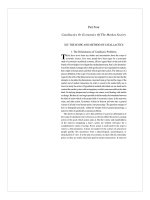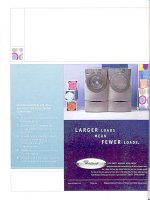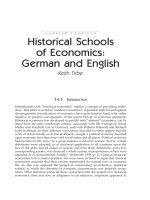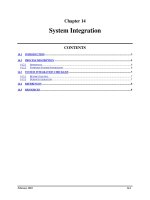micro economics chapter 14
Bạn đang xem bản rút gọn của tài liệu. Xem và tải ngay bản đầy đủ của tài liệu tại đây (179.74 KB, 20 trang )
14
Money, Banking, and
Financial Institutions
McGraw-Hill/Irwin
Copyright © 2012 by The McGraw-Hill Companies, Inc. All rights reserved.
Functions of Money
• Medium of exchange
• Used to buy/sell goods
• Unit of account
• Goods valued in dollars
• Store of value
• Hold some wealth in money form
• Money is liquid
LO1
Liquidity
Refers to ability to use an asset as a
medium of exchange. The easier it is to
convert to a medium of exchange, the
more liquid.
LO1
Money Definition M1
• M1
• Currency & coins
• Checkable deposits
• Only the most liquid assets are
•
•
LO1
included.
Coins are token money
Excludes money held by government
and banks.
Money Definition M2
• M2 = M1 + near-monies (easily
converted to be used as medium of
exchange).
• Savings deposits including money
market deposit accounts (MMDA)
• Small-denominated time deposits
• Money market mutual funds
(MMMF)
LO1
Money Definitions
LO1
What “Backs” the Money Supply
• Money as debt
• Stable value of money
• Acceptability
• Legal tender
• Relative scarcity
LO2
What “Backs” the Money Supply
• Prices affect purchasing power of
money – inverse relationship
• Hyperinflation renders money
unacceptable
• Stabilizing money’s purchasing power
• Intelligent management of the money
supply – monetary policy
• Appropriate fiscal policy
LO2
Federal Reserve - Banking System
• Historical background
• Board of Governors
• Basic policy making body of U.S.
banking system.
• 7 members appointed by president
• 14 year terms, staggered
• Chair/Vice Chair 4 year terms.
LO3
Federal Reserve - Banking System
• 12 Federal Reserve Banks
• Serve as the central bank
• Quasi-public banks
• Public control, private ownership
• Banker’s bank
LO3
Federal Reserve – Banking System
Board of Governors
Federal Open Market Committee
12 Federal Reserve Banks
Commercial Banks
Thrift Institutions
(Savings and Loan Associations,
Mutual Savings Banks,
Credit Unions)
The Public
(Households and
Businesses)
LO3
Federal Reserve – Banking System
The 12 Federal Reserve Banks
Source: Federal Reserve Bulletin
LO3
Federal Reserve – Banking System
• Federal Open Market Committee
• Conducts open market operations
• Includes Board of Governors and 5
presidents of Federal Reserve
Banks
LO3
Federal Reserve Functions
• Issue currency
• Set reserve requirements
• Lend money to banks
• Check collection
• Fiscal agent for U.S. government
• Supervise banks
• Control the money supply
LO4
Federal Reserve Independence
• Established by Congress as
•
•
LO4
independent agency
Protects the Fed from political
pressures
Enables Fed to take actions to
increase interest rates to stem
inflation as needed
The Financial Crisis of 2007 and
2008
• Mortgage Default Crisis
• Many causes
• Government programs
encouraged home ownership
• Declining real estate values
• Bad incentives provided by
mortgage-backed bonds
LO5
The Financial Crisis of 2007 and
2008
• Securitization- the process of slicing up
•
•
•
LO5
and bundling groups of loans into new
securities
As loans defaulted the system collapsed
AIG sold collateralized default swaps to
insure loans
“Underwater” homeowners abandoned
homes and mortgages
The Financial Crisis of 2007 and
2008
• Failures and Near-Failures of
•
LO5
Financial Firms
• Countrywide-second largest lender
• Washington Mutual-largest lender
• Wachovia
Other firms came close
The Financial Crisis of 2007 and
2008
• Troubled Asset Relief Program
(TARP)
• Allocated $700 billion to make
emergency loans
• Saved several institutions from failure
• Created moral hazard
LO6
Post-crisis U.S. Financial Services
• Wall Street Reform and Consumer
•
•
LO7
Protection Act
Passed to help prevent many of the
practices that led to the crisis
Critics say it adds heavy regulatory
costs









